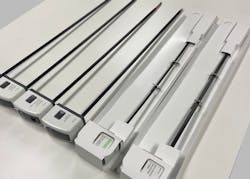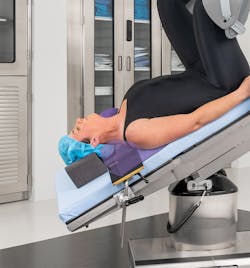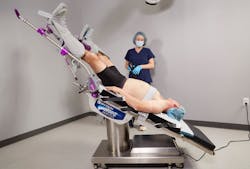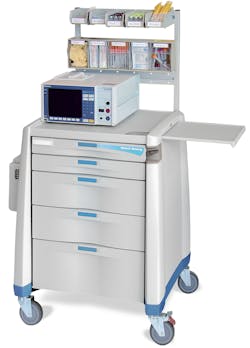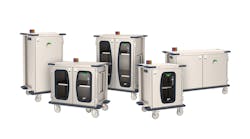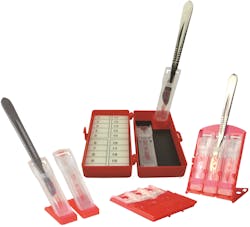The Operating Room is the center of it all. Compare it to the main stage. Or the cockpit. Or home plate. It is, rightly so, the most heavily focused upon environment within the medical arena.
In 2023, this center of operations is continually evolving, combining the latest devices and products from leading healthcare companies, all of whom are motivated by the similar desire to have their products play a crucial role within this vital scene.
However, it is the human element which still lays at the very core of successful operations in the OR, and it is important to lay emphasis on the modern OR as an evolution of the best means and methods in which many people, crammed into a tight space and on a tight schedule, can efficiently and safely perform surgical procedures. Thus, it is inherently critical to ensure the optimal performance and safety of a wide-ranging personnel in order to provide the best service to the patient.
In addition, as Ash Crowe, Senior Project Manager at St. Onge reminds us, a successful OR is a space that has been specifically optimized to fit the exact needs of the patient.
“One of the biggest advances of the modern OR is not what technology is used specifically, but how the technology and information about each patient is used. Between the EHR’s information about the patient and, once truly captured, information about the equipment, supplies, and instruments typically used by the surgeon in cases, OR preparation can and will get smarter about making sure all the right items (and just the right items) are available for the surgery. This will lead to the ability to plan better and more predictively,” stated Crowe.
Keep it clean
As ORs are a potential breeding ground for spreading infections, it is integral to keep the entire environment as clean as possible.
UltraViolet Devices, Inc (UVDI) is a company that specializes in disinfecting the OR, particularly through the application of UV technologies.
“Elective surgeries are returning post-pandemic, yet staffing shortages persist. For O.R. cleaning and surface disinfection, there is an increased need for speed – both between surgeries and for terminal disinfection at the end of the day,” stated Kristine Steely, Vice President of Global Sales, UVDI.
“To perform, UV room disinfection devices should have independently verified ability to disinfect large Operating Rooms quickly to fit into – versus disrupt – workflow. The UVDI-360 Room Sanitizer is independently proven in 18 published hospital and lab studies and independently tested 99.99% inactivation of 35 microorganisms in only 5 minutes at 8 feet – and SARS-CoV-2 at 12 feet. Proven – and fast - efficacy at a 16-foot diameter is key to ensuring the modern Operating Room keeps moving with extra surface protection.”
Protect the robot
According to Craig Ford, Founder of SteileBits, “SterileBits’ focus is on improving products/processes that have been around for a long time. For example, robotic surgery has been in existence for decades and sterilizing the instruments was accomplished by placing multiple instruments into one sterilizable tray. But with the limited use/sterilization cycles imposed by manufacturers on their disposable instruments, the practice has evolved into peel packing single instruments instead.
Every sterilization cycle of a limited use instrument has a monetary value and we saw an opportunity to protect that value. Our new Robotic Arm Instrument Protector protects the instrument during sterilization, storage, transport and delivery onto the sterile field. Our product is like an insurance policy against loss; the loss of a valuable/quantifiable use, or the loss of the instrument itself due to damage. We feel our contribution to robotic surgery plays an important part to enhancing patient care.”
Positioning is key
Safely and efficiently moving patients in the OR is critical to patient health, not to mention vital to the successful manipulation of all processes involved in a surgery. Companies such as D. A. Surgical and HoverTech International make it their chief business to ensure that patients are moved about and positioned in the most effective way possible.
D. A. Surgical’s new TrenGuard Dynamic Patient Support Frame uniquely enables OR staff to prevent slides in the Trendelenburg position when using air-assisted transfer (and other under-body devices like those used for warming/cooling).
An enhancement of the TrenGuard Trendelenburg Patient Restraint, this ‘dynamic’ frame allows 4-way movement of the positioning device. “When locked into place, the TrenGuard frame together with the patented TrenGuard trapezius bolster, prevent patient sliding in steep Trendelenburg without the use of shoulder braces or chest straps – protecting patients up to 450 pounds from positioning-related post-operative pain or injury,” stated Dan Allen, President of D. A. Surgical.
Designed to improve OR efficiencies, TrenGuard is quick and easy to use, reduces repositioning time, improves OR throughput, is competitively priced, requires less storage space, and contributes less waste than commonly used alternatives.
Shosha Beal, MSN, RN, CNOR is Clinical Education Specialist at HoverTech International.
“Patient positioning in the OR must be precise to prevent patient injuries. The use of modern positioning devices like the HoverMatt T-burg (Trendelenburg Patient Stabilization & Air Transfer Mattress) allow the OR team to reposition an unconscious patient safely with the use of air. The HoverMatt T-burg can be used to place a patient close to the anesthesia care team during induction and then with the use of air, reposition the patient for the surgical procedure.
The use of air assisted devices such as the HoverMatt provides the patient with dignity in a stressful time. A surgical procedure causes many stressors for a patient- they are cold, hungry and stressed about their surgical procedure. The use of a HoverMatt allows the patient to be moved with minimal assistance from the patient stretcher onto the OR table. At the end of the procedure the surgical team can transfer the patient onto the stretcher to be moved to the recovery area. Air assisted devices eliminate the use of a transfer board, which can be uncomfortable to a patient after a surgical procedure. It also eliminates the risk of pulling and shearing injuries to the patient.”
Keep it cool
It is important to highlight the fact that the OR is a high-stress, fast-paced environment, which has the potential to be a source of clinician burnout and injury. In response to this, Cardinal Health partnered with an OR clinician to create the CoolSource Cooling System, which can help eliminate the distraction of heat stress and give OR teams more comfort and freedom.
According to Kendra Strother, Director, U.S. Product Marketing, “Efficiency and safety are paramount in the OR. Cardinal Health brought to market the CoolSource Cooling System that can help eliminate the distraction of heat stress and give OR teams more comfort and freedom.”
In addition, Cardinal Health continues to set market trends in terms of designing and developing surgical gloves.
Strother continued, “As a market leader in synthetic gloves, made with polyisoprene and neoprene, we continue to educate clinicians on the best demonstrated practice of double-gloving to greatly reduce awareness time and risks associated with sharps injuries. Our Protexis PI Blue underglove with NEU-THERA paired with our Protexis PI Textured surgical glove, balances tactile sensitivity with protection, offering an enhanced grip and lessened hand fatigue. Surgeon and OR staff satisfaction and morale has never been more important, and Cardinal Health has and continues to invest in a way to let you know we’re listening and we care.”
It’s all about the space
The effective use of space within the OR could not be of more importance to the successful operations that go on within it, especially considering the large numbers of people who all have specific and essential duties to complete in a finite amount of time.
Tom Hillebrand, Vice President of Sales and Marketing of Pedigo, USA, spoke of how his company’s solutions aim to make best use of the available space within the OR:
“Pedigo Products offers an innovative solution to help hospitals minimize their OR costs with our adjustable two-tier back table, known as the Pedigo Space Station, and our custom-fitted drape. The two-tier table is used in more than 10,000 ORs for all surgical cases, though great benefits are seen in large surgical cases like orthopedics and neurosurgery. It helps with these cost diminishing benefits, such as:
- Reduces OR turnover time by at least 6 minutes
- Increases instrument visibility and reduces staff movement in the OR
- Standardizes the draping system and eliminates the need for double draping
Pedigo’s Space Station and disposable drape are a standalone system that provides ORs with the same capabilities that two back tables do using double draping, but in less setup time, lower cost and a number of other notable benefits. After 75 years, we continue to innovate and elevate while manufacturing lifetime value. ”
The ‘cart’ of success
Capsa Healthcare and Metro are two companies that have dedicated themselves to the advancement of medical carts utilized in an OR environment.
Capsa Healthcare’s Tryten monitor and tablet carts and Avalo medical carts are designed to provide medical professionals convenience, flexibility, and ease of use in the operating room.
“Tryten carts offer mobility, with a small, sturdy base requiring minimal floor space. The modular construction and variety of accessories and peripherals make Tryten carts suitable for various medical devices, including scopes, ultrasounds, vital sign monitors, and secondary monitors. The same cart can be used for telehealth services when consultation or observation is required. This flexibility allows surgeons to incorporate multiple devices into the OR without added clutter,” stated Ben Stewart, Director of Marketing, Capsa Healthcare.
“Avalo medical carts are constructed of HDPE for durability and easy cleaning. Their smooth, round edges eliminate sharp metal points that can catch and damage gloves or sensitive surgical equipment. Designed for flexibility, Avalo carts can be tailored to specific procedural needs including general anesthesia, difficult airway, or nerve block. Options for secure storage and tracking of meds and narcotics are available to ensure a safe OR environment,” added Joe Grabowski, Channel Sales Manager, Capsa Healthcare.
Tryten monitor and tablet carts and Avalo medical carts are a valuable addition to any operating room, optimizing workflow and creating a streamlined environment for medical professionals.”
Metro, a company that specializes in developing a wide variety of carts for the healthcare environment, recently launched their latest line of carts, CaseVue, which are designed to enhance productivity in the modern operating room.
According to Dave Salus the Metro HC manager, “CaseVue features a flag system that helps staff save valuable time by distinguishing between carts that are in need of a supply, ready for the case, or ready for return. For larger carts that support more invasive cases, CaseVue offers easy rolling casters along with 5th wheel steering, wide grip handles, and a height-adjustable handle; all of these features help to reduce the amount of effort exerted while moving and controlling these cart.”
5th wheel actuation is very intuitive, allowing OR staff to quickly and easily toggle between transport control and positioning control of the cart.
The range in sizes of the CaseVue carts also provide an invaluable tool in the OR. Whereas the short CaseVue’s worksurface can negate the need for a back table, the taller CaseVue cart can offer similar storage capacity but occupy less floor space.
To help maintain cleanliness standards and the CaseVue cart line is designed to make the most common touchpoint as clean as possible. The cool-touch corner handles are embedded with Microban antimicrobial protection to keep the handles cleaner between cleaning.
A safe cut
In terms of ensuring safety, it is important to remember the proper and careful usage of often-used tools used within the OR, such as scalpels.
Sam Kumar is the Founder and Chief Executive Officer of MYCO Medical.
“MYCO Medical offers the Qlicksmart range of single-handed scalpel blade removers which are a necessary addition to all operating rooms to ensure OSHA compliance. They were developed by two Australian clinicians who recognized the need for an Engineering Control which would prevent scalpel injuries in ORs.
The Qlicksmart range of sterile scalpel blade removers were designed to meet the needs of OR personnel and enhance safety for surgical and downstream staff. These safety-engineered devices utilize patented technology for safe and efficient sharps removal, containment, counting, and disposal.
For use outside the OR, MYCO Medical offers both the RELI-CUT retractable safety scalpel and the REDI-CUT sheathed disposable safety scalpels. Both designs offer a final lock for added safety.”

